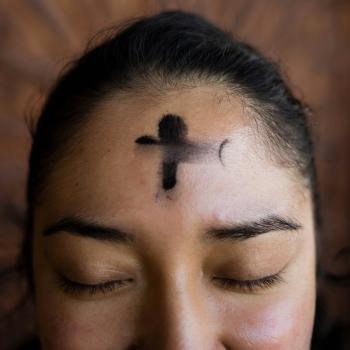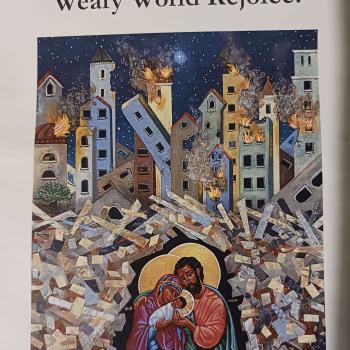In a previous post, I hinted at the distinction between looking at the Novus Ordo Mass in itself and looking at its actual practice. That there are abuses and illicit modifications, however grave, in the practice of the Novus Ordo Mass is a given. But as many medieval liturgists relate, priestly abuses have always abounded within the context of the Litrugy.
I noted the many improvements and many ancient traditions that were incorporated into the Novus Ordo Mass, which is more traditional in its spirit than is the Tridentine Mass, despite the misnomer “Traditional Latin Mass” that is often attached to the latter. One of the reasons I prefer the Novus Ordo Mass is because it strikes me as more in keeping with the totality of the liturgical tradtions–East and West–of the Catholic Church. I am very receptive of Pope Benedict XVI’s plans to have the Tridentine Mass more liberally offered, and I would never look down on someone who prefers to attend that extraordinary form of the Roman Rite liturgy. However, if this same person feels compelled to criticise the normative Novus Ordo as “objectively inferior” or “less reverent” than the Tridentine Mass, then I will continue to remind that person that the Novus Ordo is much more in accord with the most ancient, traditional liturgies of the Catholic Church.
I’ve seen in various places in the Catholic blogosphere quotes from Pope Benedict XVI on the obvious abuses and illegitimate trajectories of the Novus Ordo Mass in practice. Pope Benedict XVI has made his displeasure with the implementation and practice of the liturgical reforms of Vatican II at the parish level in some quarters well known. However, on the eve of the release of the motu proprio Summorum Pontificum, I’d like to once again balance things out, this time by providing a number of quotes where the Pope speaks glowingly of the Novus Ordo Mass when it is practiced according to form:
Thesen zum Thema ‘Zehn Jahre Vaticanum II’
“It was right and proper to open up the liturgy to the vernacular; even the Council of Trent saw it as a possibility. Furthermore, it is simply untrue to say, as the integralists do, that drawing up new forms of the Canon of the Mass is a contradiction of Trent.”
The Ratzinger Report, pp. 123-124
“In order to explain the rapid and almost total abandonment of the ancient, common language, we must also take into account a fundamental cultural change in Western public education. Even in the early sixties when I was a professor, it was possible to read Latin text to young people coming straight from German secondary schools. Nowadays, this is no longer possible.”
“Prior to Trent a multiplicity of rites and liturgies had been allowed within the Church. The Fathers of Trent took the liturgy of the city of Rome and prescribed it for the whole Church; they only retained those Western liturgies which had existed for more than two hundred years. This is what happened, for instance, with the Ambrosian rite of the Diocese of Milan. If it would foster devotion in many believers and encourage respect for piety of particular Catholic groups, I would personally support a return to the ancient situation, i.e. to a certain liturgical pluralism.”
Feast of Faith, p. 87
“Lest there be any misunderstanding, let me add that as far as its content is concerned (apart from a few criticisms), I am very grateful for the new Missal, for the way it has enriched the treasury of prayers and prefaces, for the new eucharistic prayers and the increased number of texts for use on weekdays, etc., quite apart from the availability of the vernacular. But I do regard it as unfortunate that we have been presented with the idea of a new book rather than with that of continuity within a single liturgical history. In my view, a new edition will need to make it quite clear that the so-called Missal of Paul VI is nothing other than a renewed form of the same Missal to which Pius X, Urban VIII, Pius V and their predecessors have contributed, right from the Church’s earliest history.”
Feast of Faith, p. 144 (speaking of more traditional Protestant communities)
“It always impressed me that our Protestant brethren, in transforming the medieval liturgical forms, have achieved a real balance between, on the one hand, the relationship of the community to its leader and, on the other, their common relationship to the cross. Their whole basic approach laid great weight on the community character of worship and the interplay of leader and congregation, whereas in the Catholic liturgy of former times this only consisted in the priest’s turning round for a brief ‘Dominus vobiscum‘ or to invite the people to pray. But when it is a question of praying together, Protestants, people and leader, together turn to the image of the Crucified. I think we should seriously try to learn from this.”
“Worship in the Parish Communities Fifteen Years after the Council: A Sermon Delivered to the Bishops’ Conference in Fulda”
“[W]are glad about the awakening of a new sense of common responsibility, a new experience of fellowship and of community participation in the eucharistic mystery; we rejoice in the new understanding which is abroad since the Church’s liturgy has been brought from behind the veils of history to stand before us, fresh in its simplicity and greatness of stature.
‘Community’ is the new discovery of the post-conciliar period. We have called to mind once more that Eucharist, in the language of the ancient Church, was called, among other things, synaxis, the ‘meeting together’, the assembly. It draws and binds men together, unites them, builds up community. Conversely, the community experiences Eucharist as fulfillment, as the center of its life, something in which it shares as a totality.
“There is something else: the Council reminded us most explicitly that the liturgy is, in the Church’s langauge, actio, an action. Therefore it implies the participatio actuosa, the active participation of all the faithful.”
“I would like to mention a third aspect involved in the proper celebration of the Eucharist. It is one of the happy features of worship in the wake of the Council that more and more people participate fully in the Eucharist by receiving the body of the Lord, communicating with him and, in him, with the whole Church God.”
The Spirit of the Liturgy, p. 171
“To express one of its main ideas for the shaping of the liturgy, the Second Vatican Council gave us the phrase participatio actuosa, the ‘active participation’ of everyone in the opus Dei, in what happens in the worship of God. It was quite right to do so. The Catechism of the Catholic Church points out that the word ‘liturgy’ speaks to us of a common service and thus has reference to the whole holy People of God (cf. CCC 1069).”












